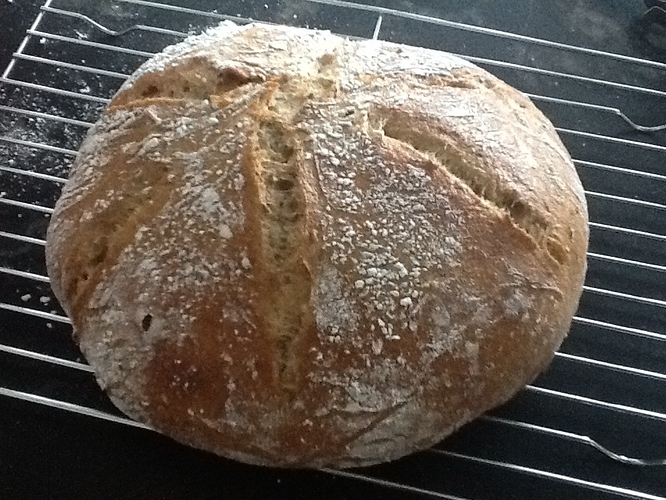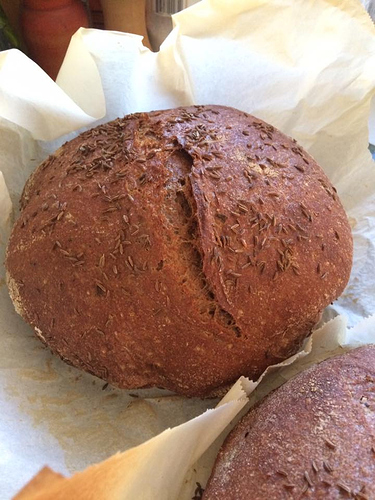To each their own.  Your method sounds complicated to me. Plus you list a bread maker that retails for about $100 and a proofer that’s $150. Whereas I haven’t had to buy a thing. Even when I’ve rented beach houses, they come with bowls, tea towels and a cast iron dutch oven somewhere in the back of the kitchen cabinets.
Your method sounds complicated to me. Plus you list a bread maker that retails for about $100 and a proofer that’s $150. Whereas I haven’t had to buy a thing. Even when I’ve rented beach houses, they come with bowls, tea towels and a cast iron dutch oven somewhere in the back of the kitchen cabinets.
I discovered this recipe last year, while I was looking for a bread special enough to bake as Christmas present for my extended family. In spite of being a very wet dough, this recipe is so well explained that even a beginner baker like me can get very nice results. Everybody loved it and here I am, ready to bake it for all of them again. Thank you!
TIP: I bake it in an cast iron pot with a lid. After baking it for 30 min at 475F with lid on and for 10 more min at 450F without cover, the inside was still not at 200F yet, so I put it back in the oven for about 8 more minutes. Here is the result!
Been trying to duplicate a 100% rye bread that an artisanal bakery ( now closed) used to make. It was sourdough with only rye , salt and water, made the conventional way but baked in a wood fired oven. Been making this great artisanal loaf for a couple of weeks and is certainly as good (almost) and certainly simpler with the no need method. Much thanks for showing the way Eric! Still waiting for someone to reveal a 100% rye no knead recipe that produces a high round loaf. Anybody? Anybody?..
Eric, thank-you for this recipe. I just took a loaf out of the oven… it smells so good, I can’t wait to taste it!
Nice!
I’ve been baking this recipe for a while … always a winner! It is really aromatherapy bread.
The last time I was a little short of fennel seed (only had 5 grams). I thought cardomom seeds would be an interesting substitution for the remaining 3 grams.
The resulting flavor was simply beautiful! The combination of orange zest and cardmom seeds is wonderful.
did you do anything to the cardamom seeds? crush or soak?
Nope. But I think a little crushing wouldn’t hurt 
And the 3 grams of cardomom seed was only a “make-do”. I really love the flavor of the cardomom. The only caution is if someone doesn’t care for the lemony-peppery flavor of cardamom, chewing a whole seed will be a surprise. Certainly not unpleasant, but a surprise in the bread.
Thanks, I’ll try this next time. I love cardamom too.
The measurements for this recipe seem off! The hydration is insanely high, 245 grams of flour + 245 gram of flour = 490 grams of flour to 400 grams of water plus 44 grams of molasses, this is 90.61 % hydration.
Also what hydration is the starter? I used a 100% rye hydration starter and this recipe just did not work, the dough after the 12 hour ferment was too sticky to shape! Can anyone comment on any of these issues!
100% hydration starter should be ok. Rye by nature is sticky and can be challenging to shape. You can cut back on the water a bit if you want.
My first attempt at baking sourdough with my newly made starter! After batch ferment, dough was VERY wet, and totally impossible to shape. So I put it into a well oiled (probably should have used baking paper?) cast iron loaf oven and let it final rise in there. It was in the sun so it did warm up somewhat. Baked at 30 minutes covered 15 uncovered produced a delicious result! (I forgot to slash it)
I’ve made this bread several times but the dough never looks as manageable as it does in your video. I bought a scale so I could make sure my amounts were exact and the dough still comes out unbelievably sticky. When I reduce the water amount I’ve noticed it becomes a a bit dense and looses its loft. Any suggestions. Oh, btw, I’m in NC and my sourdough starter is good, the dough rises super well, so no problems there.
Thank you! I watched your two videos…not too long winded for me… and the contents of the videos with the recipes gave me the “a ha” moment I have been missing…some dough is in fact too sticky to handle. I also used a ceramic bowl with a cover to cook in. So, thanks for that idea too. The bread was amazing. I made two changes. I used maple syrup instead of molasses and I ground a few grams of the seeds inside star anise pods (a different plant altogether) instead of anise. I also broke down and purchased a digital kitchen scale and a not quite instant read thermometer. Did I mention the bread was amazing?
Followed the exact recipe using store bought King Arthur Flour, I only included Sun Flower Seeds the others were omitted. My starter was 83% hydration all wheat with 13hr overnight proofing. The loaf came out perfect, excellent tang and oven spring. A great addition to my repertoire, thanks.
I know how you feel with this dough in comparison to the Breadtopia video. No matter what I’ve done, it borders on soupy after the bulk fermentation. The final product tends to be excellent, which never ceases to amaze me, since the pre-baked dough is consistently very wet, very sticky. I’ve also got a digital scale, so I have no doubt that my ratios correspond to the recipe. My dream is one day actually to hold unbaked, rye dough successfully in my hand. At least for a moment…
A couple things:
- Rye dough is always very sticky compared with wheat flours.
- Because so many things that really matter in baking a loaf of bread (especially when leavening with sourdough and baking with heirloom gains) are impossible to account for in a recipe, including variations from one flour to another, variations in proofing temperature, variations in starter activity, etc, etc, etc, I think that you should always use the specifics of a bread recipe as just a starting point and freely modify to compensate for your present conditions. Modifications that I find myself making on almost every bake include the hydration level and the bulk proofing time.
If you are always getting dough that is way too wet, try increasing the amount of flour (or decreasing the amount of water) in 50g increments.
If the dough starts off workable and then becomes too soupy by the end of your bulk proofing period, try decreasing the bulk proofing time in increments of an hour or even two.


